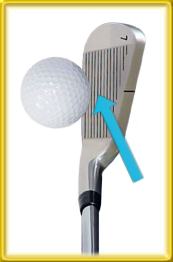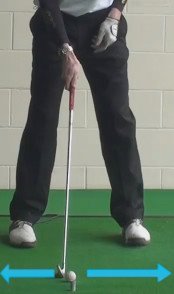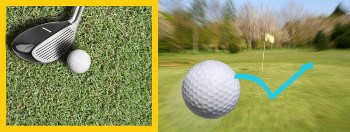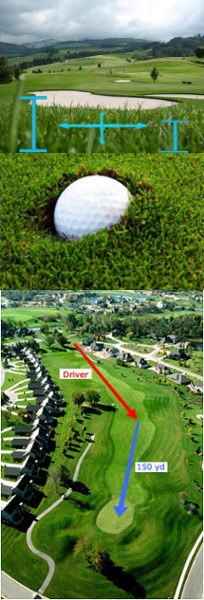
Rough that borders fairways is generally meant to punish golfers by making it harder to advance the ball all the way to the green. But sometimes, rough has the opposite effect – and that can cause even bigger headaches.
The so-called “flyer lie” usually occurs in lighter rough that offers little or no resistance to the clubhead. Instead, the grass is just fluffy enough to come between the ball and clubface, preventing the grooves from grabbing the ball and imparting backspin.
The result: A knuckling shot that flies farther than planned, then takes off running when it lands. Since many greens drop off sharply to the back -- often into trees or other trouble -- going long is often much worse than falling short.
So how do you know if you're dealing with a flyer? Look for grass behind your ball that's long enough to interfere with the clubface, but not so thick that it will slow the club down. Grass growing toward your target – rather than away from it – is another sure sign you're in flyer-ville.
Southern Bermuda grass is notorious for producing flyers, especially when it's dry. “Stickier” grasses, like bent, rye and fescue are less flyer-prone. Grass that's heavy with moisture tends to slow the club – reducing flyers – while dew or light rain increase the risk of flyers.
Here are a few basic steps for dealing with flyer lies:

• Take less club: If your distance calls for, say, a 7-iron, hit an 8-iron or even a 9, depending on whether you're better off missing short or long.
• Aim short of the green: If you're playing to a green that's open in front, choose the club that will land the ball short. Its lack of spin will send the ball bounding onto the green.
• Play the ball farther back in your stance: Let's say you've picked a 7-iron, which you normally play in the middle of your stance. Move it an inch or so toward your right foot (for right-handers) to create a steeper swing and minimize clubface contact with grass.
One more thing: A ball that's found the fairway isn't necessarily immune. In fact, lightly wet fairways are a key flyer breeding ground, since water fills the grooves on contact. That's one reason professional caddies are obsessive about keeping clubs dry. No one wants to get fired over a flyer.

Keys to Handling the Flyer Lie
The flyer lie is one of the trickiest situations in golf. When you 'catch a flyer', the ball is likely to shoot over your target and not come to rest until it has found some kind of trouble. As a beginning golfer, you probably thought of shots out of the rough as ones which would land short of the green. That is usually true, but as you learn as you gain experience, sometimes shots from the rough just don't want to come down at all. These flyers can be seriously damaging to your scorecard, so you need to know how to handle them as effectively as possible.
In this article, we are going to cover this topic from all angles. We will define what a flyer lie is and how you can recognize it before hitting your shot. Also, we will discuss the adjustments you can make to reduce the chances of actually hitting a flyer. This shot will always be a possibility when playing from the rough, but you can improve your odds of avoiding it by taking the right steps. The flyer is even a possibility in the short game, so we are going to talk about that area of play as well.
So what is a flyer? Basically, this is a shot that is hit from the rough and comes out with very little spin. Without the backspin necessary to climb up into the sky, the ball will hold a flat trajectory and carry for a surprising distance. Then, when it lands, it will usually take a couple of big bounces, again due to the lack of backspin. The golfer has very little control over the ultimate destination of the shot when a flyer occurs. Once you feel that a flyer has taken place, all you can do is ask the ball to get down and hope for the best.
This is different from a 'normal' shot out of the rough because of the velocity involved. Regular shots out of the rough don't have much spin either, but they don't have the speed of a flyer. The rough around the ball slows down the club so much that the shot comes out short and lacking spin. When you watch a golf tournament on TV where there is deep rough in play, these are usually the kinds of shots you see. However, most golf courses which are open to the public don't keep long rough, so flyers are extremely common. In fact, when you drive the ball into the rough, you should probably be more worried about hitting a flyer than anything else.
All of the content below is written from the perspective of a right-handed golfer. If you happen to play left-handed, please take a moment to reverse the directions as necessary.

How to Spot a Flyer Lie
If you are going to handle a flyer lie successfully, you first have to see it coming. While you are never going to be able to predict this type of shot with 100% accuracy, you can watch for signs that will make a flyer more likely. As with anything else in golf, experience is going to play a big role here. The more golf you play, and the more times you find your ball in the rough, the better you will get and deciding what is and isn't a flyer lie.
To help jump start your education on this point, please review the following tips.
- Watch for medium rough. This is the starting point when checking for a flyer lie. If your ball comes to rest in grass which could be described as medium in length, you may be at risk for hitting a shot over your target. It is hard to attach an exact length to this kind of grass, but you will probably know it when you see it. When you set your club down behind the ball, the blades of grass should reach up beyond the middle of the club face. If they are much shorter than that, there probably isn't enough grass to catch too much of a flyer. On the other hand, if they are longer than that, you will lose too much speed through impact to worry about a flyer taking place. This type of rough doesn't look particularly daunting when you are getting ready to hit your shots, but the possibility of a flyer should have your full attention.
- Grass behind the ball. In order to catch a flyer, there will need to be some grass behind the golf ball at impact. It is these blades of grass which are going to be responsible for your shot coming out with very little spin. If there happens to be a bare patch behind your ball with very little grass, you can probably get away without hitting a flyer. When grass is trapped between the ball and the club face at impact, friction is reduced and spin rate drops significantly. It is these kinds of shots that come out flat and wind up sailing well beyond their intended target.
- Distance matters as well. When trying to determine whether or not you are at risk for hitting a flyer, you should take the distance of the shot into account. The biggest risk is when playing shots from a distance that requires the use of your middle irons. Generally, the most common situation for a flyer to result is when hitting something between a six iron and nine iron into the green. It is possible to hit flyers with other clubs, but they are less common. With short irons, you will have so much height on the shot that the flyer might not do that much damage – the shot may wind up a little long, but it shouldn't be too bad. On the other end, long iron shots don't have tremendously high spin rates anyway, so the difference here is often negligible. It is when you are going to play a middle iron and you think you have a flyer lie that you really need to be concerned.
- Think about conditions. You may be surprised to know that weather conditions can impact flyer lies as well. Specifically, you will be more likely to catch a flyer when you are playing on a wet day. When the grass is wet – as a result of rain, or even morning dew – there will be less friction present for the meeting of the ball and the club face. Spin rates can be reduced even further in this case, and the flyer outcome will be very possible.
It takes an experienced eye to spot a flyer lie. However, now that you know what to watch for, you will be able to start seeing them more and more often even without much experience behind you. Pay attention anytime you walk into the rough and carefully examine the turf around your ball before planning your shot. There might not be anything you can do to gain total control over this kind of shot, but you can at least make a plan which will limit the damage that this lie can do.

Making a Few Physical Adjustments
Once you have decided that you are dealing with a potential flyer lie, you will want to make a few adjustments to your swing technique. These changes aren't going to be anything particularly drastic, but they will be enough to impact the final result of the shot. Even though you won't have flyer conditions on the driving range, you should still practice these swing changes on the range just to make sure you are comfortable with them when the situation arises on the course.
The following three points are the key physical adjustments you should make when a flyer is a possibility.
- Choke down on the grip. It probably seems like you are told to choke down on the grip of the club anytime your ball is in a difficult spot – and that is true, for the most part. By choking down on the grip, you will increase your control over the club during the swing. That means you are more likely to make solid contact, and making good contact can help you get as much spin as is possible from this lie. Another benefit of choking down on the grip is the fact that you are going to lose a little swing speed along the way. If you do happen to catch a flyer, the decrease in your swing speed will help prevent the ball from going too far beyond the target.
- Play the ball slightly forward in your stance. Many golfers move the ball back in their stance when they stray into the rough. That might work in some situations, but it would be the wrong move here. Moving the ball back in your stance will cause the shot to come out even lower, and that is not what you want to have happen in this case. By moving the ball up, you should be able to pick up a little bit of launch angle, which will help to keep this shot under control. You probably won't gain any spin this way, but the higher launch should take a bit of distance off the ball and cause it to stop quicker as well.
- Open the face at address. This is a bit of a 'pro move', but it is one which just about any amateur should be able to try. When you set up to the ball, open the face of your club just slightly. Then, make your swing as usual. With the face open, the ball should come out a little higher than it would otherwise. Also, you might be able to squeeze out a little extra spin by using this technique. Don't worry about the open face leading to a slice, or even a fade. Most likely, when coming out of this kind of lie, the ball will fly almost perfectly straight.
That's it – by choking down on the grip, playing the ball forward in your stance, and opening the face of the club, you can do your best to minimize the effect of the flyer lie. This doesn't mean that the flyer is no longer a problem, it just might not be as big of a problem as it was before. Using these adjustments should take the extreme results out of play. In other words, instead of a shot which flies way over the green and into trouble, you might only miss your intended distance by a small amount. Still not an ideal result, but better than it could have been.

Making Mental Adjustments
The adjustments you make on the mental side of the game might be even more important than the physical adjustments we outlined above. By making smart decisions, you can again mitigate the damage that will be done by a flyer lie. Golf is a game of decisions, and the more good ones you make during the course of a given round, the better off you will be.
So what can you do from a decision making stand point to improve your chances when it comes to a flyer lie? The following tips should help.
- Use one less club. This should be an automatic reaction to finding that you have a possible flyer lie in the rough. As soon as you see that the lie may lead to a flyer, take one less club than you would have used for the yardage otherwise. By clubbing down, you will counteract some of the likely distance gain that you will experience from the lie. The only exception to this rule is when you are playing over some kind of hazard. If you need the ball to at least carry a certain distance to stay out of trouble, you might want to stick with the original club. Using less club not only causes the shot to travel a shorter distance, but it also gives you more loft and a higher trajectory to work with.
- Consider laying up. This might sound like a bit of a radical notion, but sometimes taking a chance on a flyer lie simply isn't worth the risk. For example, imagine you are playing a shot to a green which has a deep bunker guarding the back of the putting surface. If your ball carries too far, or even lands on the green but bounces into the bunker, you will be facing a nearly impossible shot. Why even take the chance in this situation? You will be better served to lay up with your current shot, avoid the flyer altogether, and do your best to hit the next one close. This strategy will take the big number out of play, and you might even still be able to save a par. It will require patience to lay up when you can easily reach the green, but doing so might end up being in your best interest when all is said and done.
- Play to the biggest possible target. When you have to hit a shot from a flyer lie, you are going to have a limited amount of control over the ball. Knowing that, you should always be giving yourself the most margin for error that you can find. So, if you are going for the green, aim at the big part of the green where your ball will have the most room to roam. It would be a mistake to aim over at a small corner of the putting surface just because that's where the pin happens to be located. You aren't worried about the pin right now – and you certainly shouldn't be worried about making a birdie. The goal is a par in this type of situation, and the best way to find that par is to put the odds in your favor. Play this shot as safe as you can and move on.
Patience is the name of the game when it comes to dealing with a flyer lie. If you wanted to be more aggressive with your approach shot, you should have hit your tee shot in the fairway. Now that you find yourself in the rough dealing with a possible flyer, you need to calm yourself down, think rationally, and play a safe shot. Your round can easily get away from you if you decide to be aggressive out of this flyer lie in an attempt to still make a birdie. Don't let one bad decision ruin the rest of your round. Be smart, be patient, and use what you have learned to complete the hole as successfully as possible.

Flyers in the Short Game
No golf instruction discussion would be complete without covering the short game. The short game tends to be overlooked too often, despite the fact that it is incredibly important to the score you wind up writing on your card at the end of the day. Since you can draw a flyer around the greens just like you can back in the rough along the fairway, it is important to touch on this topic before we conclude.
The first thing you need to know about flyer lies in the short game is that they look exactly the same as what we described earlier. If you have learned how to spot a flyer for your full swing, you already know how to spot one in the short game. Anytime you find your ball in the medium rough around the green, take a careful look at the lie to decide if you think it might be a flyer.
When you do think you have a flyer lie around the greens, you should plan on the ball coming out quickly and taking a big bounce when it lands. You probably won't hit the ball all the way over the green like you might from farther back – these are smaller swings and shorter shots, after all – but you could still hit the ball well beyond the target. Adjust the size of your swing to account for the fact that you think the ball is going to come out quickly, and change your intended landing spot as well. There will always be an element of guesswork involved in this kind of shot, but you should get better and better at it as time moves along.
If at all possible, you should try to play lower chip and pitch shots when you think you have a flyer lie. Since low bump-and-run type of shots don't use spin to stop the ball anyway, there won't be much difference between this shot and one hit from a good lie. You will already be planning on a big bounce and plenty of roll out, so you might as well use a shot that plays right into that style.
Should you find that you have to play a downhill chip shot from a possible flyer lie, you may want to consider turning to a flop shot in order to give yourself a chance to stop the ball. If you hit a regular chip with a somewhat flat trajectory, it will be hard to get the ball to stop until it rolls off the green on the other side. By opting for the flop, you can put plenty of air under the ball and hopefully bring it down softly. This is still going to be a very difficult shot to pull off, but it might be your only real option.
Flyer lies are no fun. They actually don't look that scary when you encounter one on the course, since you can see most of the ball at address and you should be able to hit the shot far enough with ease. The devil is in the details, however. You won't have enough spin on the ball to control it properly, and it will be nearly impossible to guess accurately on your distance. Use the advice offered throughout this article to improve the way you deal with these kinds of shots when they arise. Good luck!





